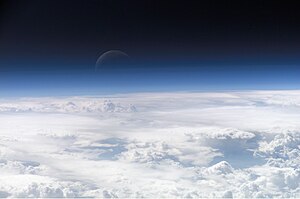 Image via Wikipedia
Image via WikipediaIt is widely known that the ozone layer, part of the stratosphere, filters ultraviolet radiation out of sunlight. Without this filtering, life as we know it could not exist: UV light is much higher energy than visible sunlight: it breaks chemical bonds, excites particles and heats them up, and generally messes with everything that it touches. So the ozone is pretty important.
A slightly lesser known fact, however, is that ozone makes up only about 40 parts per billion (ppb) of the earth’s atmosphere. That means that for every billion molecules of gas in the air, only 40 are that special UV collecting combination of three oxygen atoms. Even at its highest concentration, in the lower portion of the stratosphere which is named after it, ozone accounts for only about 8 parts per million (ppm). Now, while that is an order of magnitude more concentrated than the rest of the atmosphere, it is still only 0.0008%. And yet, this tiny, minuscule amount of O3 filters about 98% of the UV light that is emitted by the sun, thus saving the life of everything on earth every day.
Recently a skeptical acquaintance asked if I really believed in “that global warming stuff.” I informed him that in fact I did, and he proceeded to ask me if I knew how much CO2 was actually in the atmosphere. I did not have the number memorized, but I knew it was very small. “Less than .05%” he informed me (to be a bit more precise, it is about 385ppm). He continued “do you really expect me to believe that that tiny amount of stuff is going to change the temperature of the entire earth?” Without quick access to my facts, all I could do was weakly say “yes, but I can’t really explain why right now.”
Well, now that I have been able to go back over my notes and do some more research, I can boldly say (and I hope my skeptical friend gets to read this) “yes, I expect you to believe it, because if such a tiny amount of gas couldn’t absorb so much energy, we would all be dead.” If 8ppm of O3 can absorb 98% of UV energy, then is it really so hard to believe that 385ppm of CO2 could absorb a significant amount of the infrared energy that the earth emits? Greenhouse gasses (GHGs) like CO2 absorb much of the earth’s energy, and they scatter it all around. Some of it warms the atmosphere, some is emitted out into space, and some emitted back to the earth. The more GHGs there are, the more of that energy is trapped and emitted back to the earth.
It has been estimated that in recent history the amount of CO2 in the atmosphere has increased by 2ppm every year, due almost entirely to humans burning fossil fuels. That may not seem like much, but that means an increase of 8ppm (which, if you remember, is the maximum concentration of ozone) every four years. I don’t think many climate scientists are suggesting that some catastrophic event is going to end the human race over night, or even in a decade or two, but it does seem reasonable that increasing green house gas emissions steadily over a long period of time will result, in that long period of time, in a warmer planet.
Just 8 ozone particles in a million units, just 0.0008% of gas molecules make this planet habitable. In atmospheric science, numbers that tiny are not only significant, they tend to describe the most significant phenomena of all.

No comments:
Post a Comment